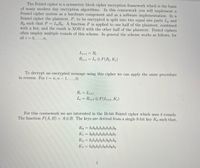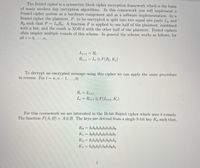
Database System Concepts
7th Edition
ISBN: 9780078022159
Author: Abraham Silberschatz Professor, Henry F. Korth, S. Sudarshan
Publisher: McGraw-Hill Education
expand_more
expand_more
format_list_bulleted
Question
could you please code this on notepade.

Transcribed Image Text:The Feistel cipher is a symmetric block cipher encryption framework which is the basis
of many modern day encryption algorithms. In this coursework you will implement a
Feistel cipher system as a hardware component and as a software implementation. In a
Feistel cipher the plaintext, P, to be encrypted is split into two equal size parts Lo and
Ro such thatP = L,Ro- A function F is applied to one half of the plaintext, combined
with a key, and the result is XOR'd with the other half of the plaintext. Feistel ciphers
often employ multiple rounds of this scheme. In general the scheme works as follows, for
all i = 0, .. . , n,
L;+1= R;
R+1 = L; © F(R, K;)
To decrypt an encrypted message using this cipher we can apply the same procedure
in reverse. For i = n, n – 1, . , 0,
R; = L,+1
Lat1
L, = R,-1 e F(L,-1, K.)
For this coursework we are interested in the 16-bit Feistel cipher which uses 4 rounds.
The function F(A, B) = AOB. The keys are derived from a single 8-bit key Ko such that,
Ko = b,b6b;b4b3bzbi bo
K1 = b6b5b,b3b2bibob,
K2 = b;b,bzb,b,bob-b6
K3 = b,b3b2b1bob-b6b5
1

Transcribed Image Text:The Feistel cipher is a symmetric block cipher encryption framework which is the basis
of many modern day encryption algorithms. In this coursework you will implement a
Feistel cipher system as a hardware component and as a software implementation. In a
Feistel cipher the plaintext, P, to be encrypted is split into two equal size parts Lo and
Ro such thatP = L,Ro- A function F is applied to one half of the plaintext, combined
with a key, and the result is XOR'd with the other half of the plaintext. Feistel ciphers
often employ multiple rounds of this scheme. In general the scheme works as follows, for
all i = 0, .. . , n,
L;+1= R;
R+1 = L; © F(R, K;)
To decrypt an encrypted message using this cipher we can apply the same procedure
in reverse. For i = n, n – 1, . , 0,
R; = L,+1
Lat1
L, = R,-1 e F(L,-1, K.)
For this coursework we are interested in the 16-bit Feistel cipher which uses 4 rounds.
The function F(A, B) = AOB. The keys are derived from a single 8-bit key Ko such that,
Ko = b,b6b;b4b3bzbi bo
K1 = b6b5b,b3b2bibob,
K2 = b;b,bzb,b,bob-b6
K3 = b,b3b2b1bob-b6b5
1
Expert Solution
This question has been solved!
Explore an expertly crafted, step-by-step solution for a thorough understanding of key concepts.
This is a popular solution
Trending nowThis is a popular solution!
Step by stepSolved in 3 steps with 1 images

Knowledge Booster
Learn more about
Need a deep-dive on the concept behind this application? Look no further. Learn more about this topic, computer-science and related others by exploring similar questions and additional content below.Similar questions
- You can also download the image file from https://www.dropbox.com/scl/fi/ztmuke5mlonrb3e0jdpuj/Santa.jpg?rlkey=lfdzstv649h141jolqdh2kagv&dl=0(1) Write a code to change all red color pixels into blue.(2) Write a code to change only the right half of the red hat into blue, using two ifarrow_forwardthis is my code, but after automatically check it, it shows smt went wrong(image one) image two is the spec for nextTweet and below is my code, since it's the system automatically check the code, I dont really have a textcases. plz debug it and fix it. show the screenshot of the code when u finish. thanks Below is my whole code for TweetBot import java.util.*;import java.io.*; public class TweetBot { private List<String> tweets; private int index; public TweetBot(List<String> tweets){ if(tweets.size() < 1){ throw new IllegalArgumentException("need contain at least one tweet!"); } this.tweets = new ArrayList<>(tweets); } public int numTweets(){ return tweets.size(); } public void addTweet(String tweet) { tweets.add(tweet); if (tweets.size() == 1) { // if the tweet was the first one added, set the index to 0 index = tweets.size() - 1; } } public…arrow_forwardTextBox and MaskedTextBox: What's the Difference? how to make textbox utilize all uppercase or lowercase characters?arrow_forward
- Can you please answer the following question? The program is JavaScript and needs to look exactly like the example attached. Thanks!arrow_forwardPlease Help with Java Script eventListeners 1. Add an event listener to the button with an id of "button1". Listen for the click event. The button should change the text content of the paragraph with an id of "p1" to:"Hello World! I'm listening to events." This did NOT work://const button1 = document.querySelector("button1");//const p1 = document.querySelector("p1");//const click = () => {// alert("Hello World! I'm Listening to events.");//} //button1.addEventListener("click", p1, false); This did NOT workconst button1 = document.querySelector("button1");const p1 = button1.querySelector("p1");button1.addEventListener("click", function (event) {event.p1.target.textContent = "Hello World! I'm Listing to events.";}); 2) Add an event listener to the button with an idof "button2". Listen for the click event. Thebutton should change the text content of theparagraph with an id of "p2" to:"This button toggles text content."If the button is clicked a 2nd time,the text content should change…arrow_forwardThank you! This worked. The final thing is, I need the data from the itemPrice and itemName submitted in the code to go into a textbox called "txtPriceName". I do not know how else to edit it further for it to do this.arrow_forward
arrow_back_ios
arrow_forward_ios
Recommended textbooks for you
 Database System ConceptsComputer ScienceISBN:9780078022159Author:Abraham Silberschatz Professor, Henry F. Korth, S. SudarshanPublisher:McGraw-Hill Education
Database System ConceptsComputer ScienceISBN:9780078022159Author:Abraham Silberschatz Professor, Henry F. Korth, S. SudarshanPublisher:McGraw-Hill Education Starting Out with Python (4th Edition)Computer ScienceISBN:9780134444321Author:Tony GaddisPublisher:PEARSON
Starting Out with Python (4th Edition)Computer ScienceISBN:9780134444321Author:Tony GaddisPublisher:PEARSON Digital Fundamentals (11th Edition)Computer ScienceISBN:9780132737968Author:Thomas L. FloydPublisher:PEARSON
Digital Fundamentals (11th Edition)Computer ScienceISBN:9780132737968Author:Thomas L. FloydPublisher:PEARSON C How to Program (8th Edition)Computer ScienceISBN:9780133976892Author:Paul J. Deitel, Harvey DeitelPublisher:PEARSON
C How to Program (8th Edition)Computer ScienceISBN:9780133976892Author:Paul J. Deitel, Harvey DeitelPublisher:PEARSON Database Systems: Design, Implementation, & Manag...Computer ScienceISBN:9781337627900Author:Carlos Coronel, Steven MorrisPublisher:Cengage Learning
Database Systems: Design, Implementation, & Manag...Computer ScienceISBN:9781337627900Author:Carlos Coronel, Steven MorrisPublisher:Cengage Learning Programmable Logic ControllersComputer ScienceISBN:9780073373843Author:Frank D. PetruzellaPublisher:McGraw-Hill Education
Programmable Logic ControllersComputer ScienceISBN:9780073373843Author:Frank D. PetruzellaPublisher:McGraw-Hill Education

Database System Concepts
Computer Science
ISBN:9780078022159
Author:Abraham Silberschatz Professor, Henry F. Korth, S. Sudarshan
Publisher:McGraw-Hill Education

Starting Out with Python (4th Edition)
Computer Science
ISBN:9780134444321
Author:Tony Gaddis
Publisher:PEARSON

Digital Fundamentals (11th Edition)
Computer Science
ISBN:9780132737968
Author:Thomas L. Floyd
Publisher:PEARSON

C How to Program (8th Edition)
Computer Science
ISBN:9780133976892
Author:Paul J. Deitel, Harvey Deitel
Publisher:PEARSON

Database Systems: Design, Implementation, & Manag...
Computer Science
ISBN:9781337627900
Author:Carlos Coronel, Steven Morris
Publisher:Cengage Learning

Programmable Logic Controllers
Computer Science
ISBN:9780073373843
Author:Frank D. Petruzella
Publisher:McGraw-Hill Education